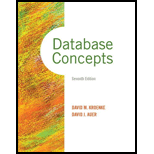
EBK DATABASE CONCEPTS
7th Edition
ISBN: 9780133777840
Author: AUER
Publisher: VST
expand_more
expand_more
format_list_bulleted
Concept explainers
Question
Chapter 3, Problem 3.16RQ
Program Plan Intro
Display values from table:
The contents from the table can be viewed by using “SELECT” statement which comes under Data Manipulation Language (DML).
The Syntax to view the contents using asterisk (*) is as follows:
SELECT * FROM table_Name;
Columns can also be retrieved by replacing all the column names in place of the asterisk symbol.
The Syntax to view the contents is as follows:
SELECT ColName1, ColName2, …, ColNameN FROM table_Name;
Expert Solution & Answer
Want to see the full answer?
Check out a sample textbook solution
Students have asked these similar questions
How can I perform Laplace Transformation when using integration based on this?
Write an example of a personal reflection of your course.
- What you liked about the course.
- What you didn’t like about the course.
- Suggestions for improvement.
Course: Information and Decision Sciences (IDS)
The Reflection Paper should be 1 or 2 pages in length.
How can I perform Laplace Transformation when using integration ?
Chapter 3 Solutions
EBK DATABASE CONCEPTS
Ch. 3 - Prob. 3.1RQCh. 3 - What is a data sublanguage?Ch. 3 - Prob. 3.3RQCh. 3 - Prob. 3.4RQCh. 3 - Prob. 3.5RQCh. 3 - Why do some standard SQL-92 statements fail to run...Ch. 3 - Use the following tables for your answers to...Ch. 3 - Write an SQL CREATE TABLE statement to create the...Ch. 3 - Prob. 3.9RQCh. 3 - Prob. 3.10RQ
Ch. 3 - Prob. 3.11RQCh. 3 - Is PET or PET_2 a better design? Explain your...Ch. 3 - Prob. 3.13RQCh. 3 - Prob. 3.14RQCh. 3 - Prob. 3.15RQCh. 3 - Prob. 3.16RQCh. 3 - Prob. 3.17RQCh. 3 - Write an SQL statement to display the breed, type,...Ch. 3 - Prob. 3.19RQCh. 3 - Prob. 3.20RQCh. 3 - Write an SQL statement to display the breed, type,...Ch. 3 - Write an SQL statement to display the name, breed,...Ch. 3 - Prob. 3.23RQCh. 3 - Prob. 3.24RQCh. 3 - Prob. 3.25RQCh. 3 - Write an SQL statement to display the name and...Ch. 3 - Prob. 3.27RQCh. 3 - Write an SQL statement to count the number of...Ch. 3 - Write an SQL statement to count the number of...Ch. 3 - Prob. 3.30RQCh. 3 - Prob. 3.31RQCh. 3 - Prob. 3.32RQCh. 3 - Prob. 3.33RQCh. 3 - Answer question 3.33, but do not consider any pet...Ch. 3 - Write an SQL statement to display the last name,...Ch. 3 - Write an SQL statement to display the last name,...Ch. 3 - Write SQL statements to (1) create the BREED...Ch. 3 - Prob. 3.38RQCh. 3 - Prob. 3.39RQCh. 3 - Prob. 3.40RQCh. 3 - Write an SQL statement to display the...Ch. 3 - Write SQL statements to add three new rows to the...Ch. 3 - Write SQL statements to add three new rows to the...Ch. 3 - Prob. 3.44RQCh. 3 - Explain what will happen if you leave the WHERE...Ch. 3 - Prob. 3.46RQCh. 3 - Prob. 3.47RQCh. 3 - Prob. 3.48RQ
Knowledge Booster
Learn more about
Need a deep-dive on the concept behind this application? Look no further. Learn more about this topic, computer-science and related others by exploring similar questions and additional content below.Similar questions
- I need help in explaining how I can demonstrate how the Laplace & Inverse transformations behaves in MATLAB transformation (ex: LIke in graph or something else)arrow_forwardYou have made the Web solution with Node.js. please let me know what problems and benefits I would experience while making the Web solution here, as compared to any other Web solution you have developed in the past. what problems and benefits/things to keep in mind as someone just learningarrow_forwardPHP is the server-side scripting language. MySQL is used with PHP to store all the data. EXPLAIN in details how to install and run the PHP/MySQL on your computer. List the issues and challenges I may encounter while making this set-up? why I asked: I currently have issues logging into http://localhost/phpmyadmin/ and I tried using the command prompt in administrator to reset the password but I got the error LOCALHOST PORT not found.arrow_forward
arrow_back_ios
SEE MORE QUESTIONS
arrow_forward_ios
Recommended textbooks for you
 Programming with Microsoft Visual Basic 2017Computer ScienceISBN:9781337102124Author:Diane ZakPublisher:Cengage LearningCOMPREHENSIVE MICROSOFT OFFICE 365 EXCEComputer ScienceISBN:9780357392676Author:FREUND, StevenPublisher:CENGAGE LNp Ms Office 365/Excel 2016 I NtermedComputer ScienceISBN:9781337508841Author:CareyPublisher:Cengage
Programming with Microsoft Visual Basic 2017Computer ScienceISBN:9781337102124Author:Diane ZakPublisher:Cengage LearningCOMPREHENSIVE MICROSOFT OFFICE 365 EXCEComputer ScienceISBN:9780357392676Author:FREUND, StevenPublisher:CENGAGE LNp Ms Office 365/Excel 2016 I NtermedComputer ScienceISBN:9781337508841Author:CareyPublisher:Cengage
 A Guide to SQLComputer ScienceISBN:9781111527273Author:Philip J. PrattPublisher:Course Technology Ptr
A Guide to SQLComputer ScienceISBN:9781111527273Author:Philip J. PrattPublisher:Course Technology Ptr Database Systems: Design, Implementation, & Manag...Computer ScienceISBN:9781285196145Author:Steven, Steven Morris, Carlos Coronel, Carlos, Coronel, Carlos; Morris, Carlos Coronel and Steven Morris, Carlos Coronel; Steven Morris, Steven Morris; Carlos CoronelPublisher:Cengage Learning
Database Systems: Design, Implementation, & Manag...Computer ScienceISBN:9781285196145Author:Steven, Steven Morris, Carlos Coronel, Carlos, Coronel, Carlos; Morris, Carlos Coronel and Steven Morris, Carlos Coronel; Steven Morris, Steven Morris; Carlos CoronelPublisher:Cengage Learning

Programming with Microsoft Visual Basic 2017
Computer Science
ISBN:9781337102124
Author:Diane Zak
Publisher:Cengage Learning

COMPREHENSIVE MICROSOFT OFFICE 365 EXCE
Computer Science
ISBN:9780357392676
Author:FREUND, Steven
Publisher:CENGAGE L

Np Ms Office 365/Excel 2016 I Ntermed
Computer Science
ISBN:9781337508841
Author:Carey
Publisher:Cengage


A Guide to SQL
Computer Science
ISBN:9781111527273
Author:Philip J. Pratt
Publisher:Course Technology Ptr

Database Systems: Design, Implementation, & Manag...
Computer Science
ISBN:9781285196145
Author:Steven, Steven Morris, Carlos Coronel, Carlos, Coronel, Carlos; Morris, Carlos Coronel and Steven Morris, Carlos Coronel; Steven Morris, Steven Morris; Carlos Coronel
Publisher:Cengage Learning